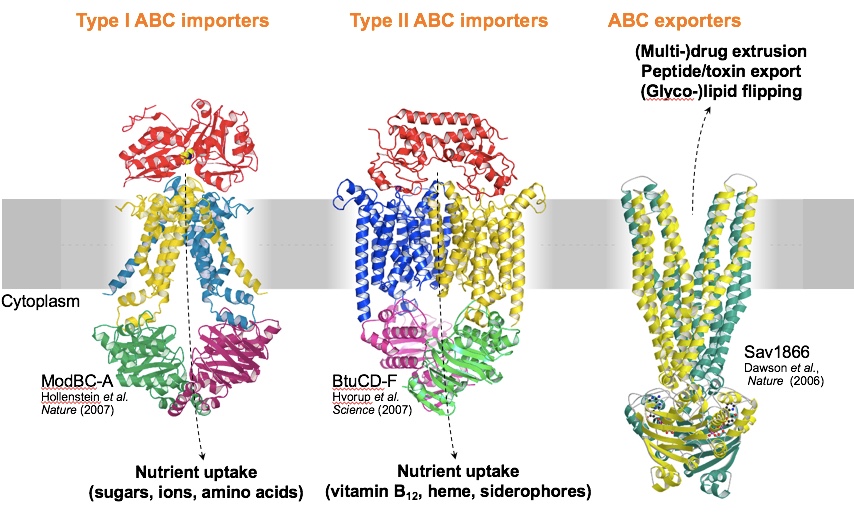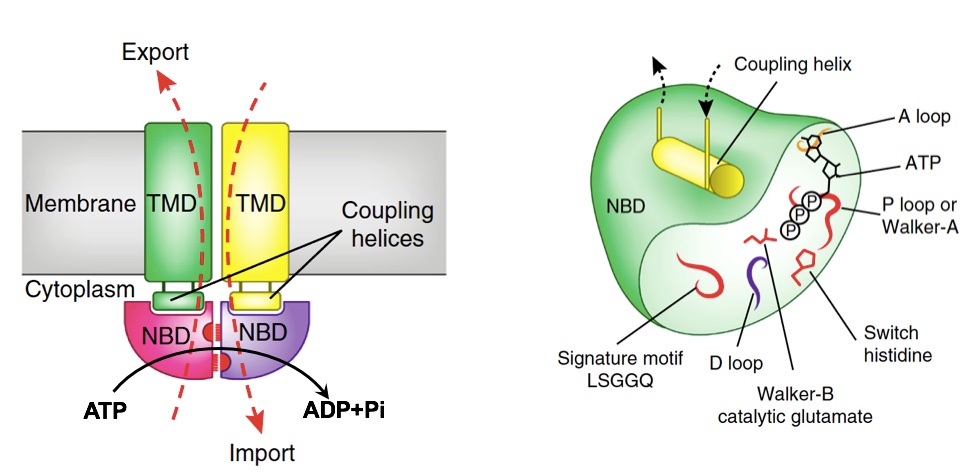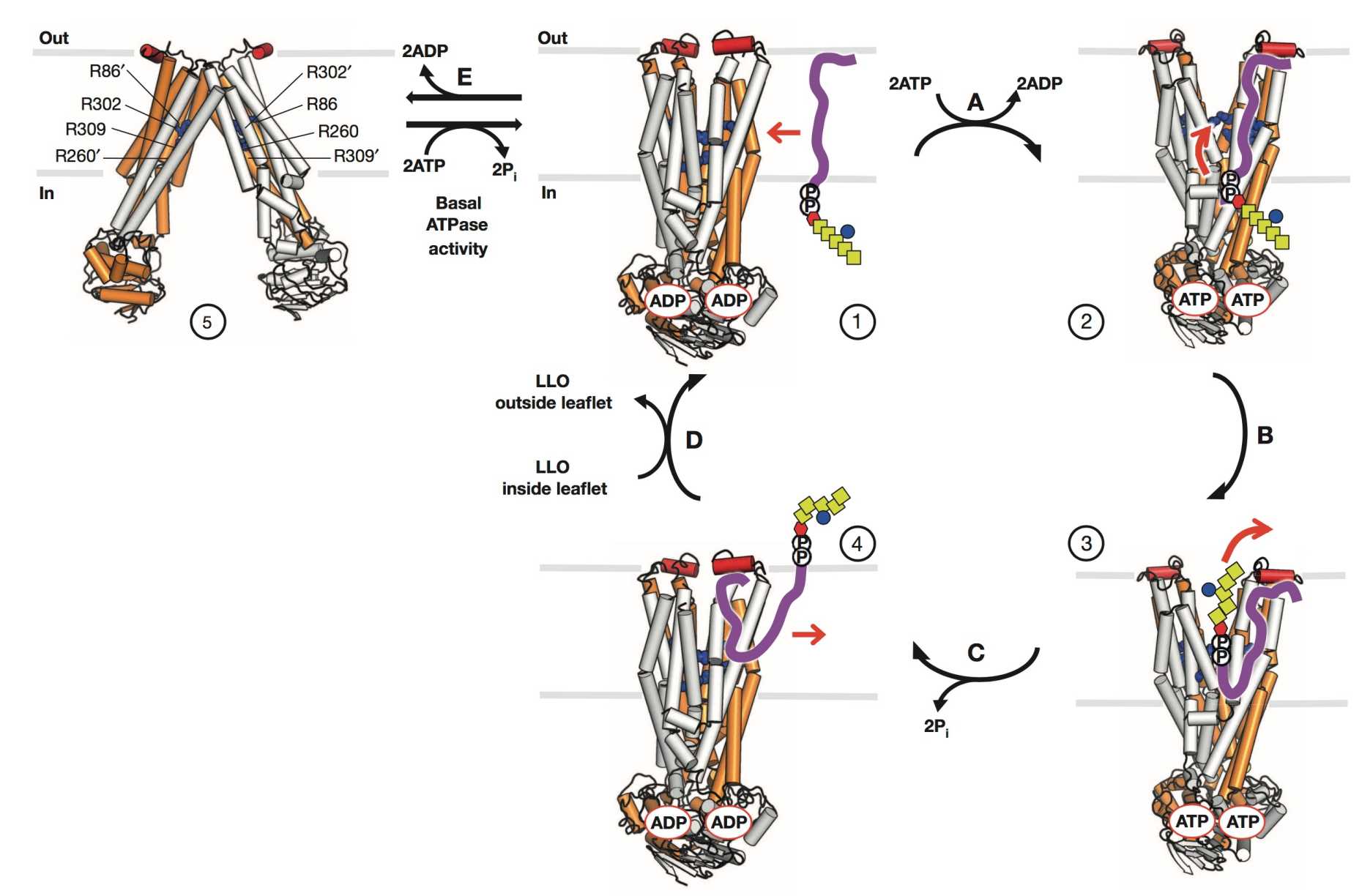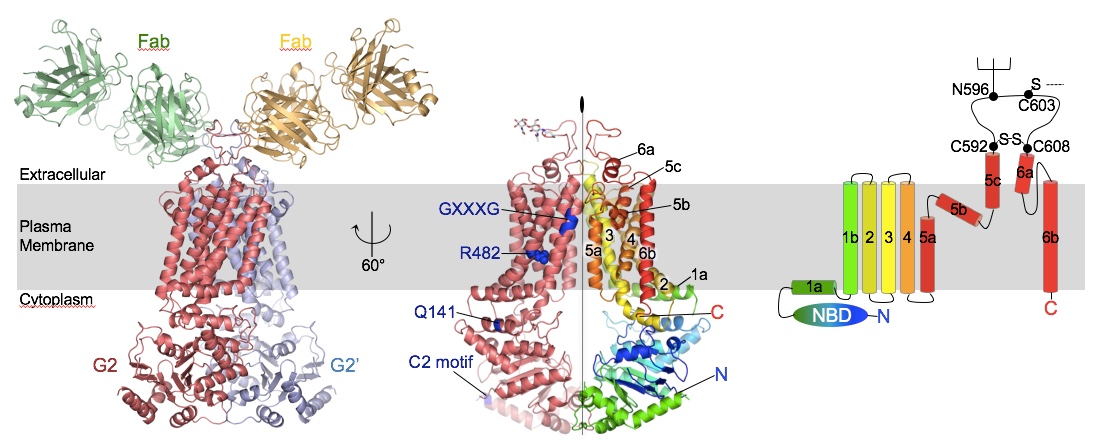ABC Transporters
ABC transporters catalyzing the extrusion of drugs, metabolites, and (glyco)-lipids
ATP-binding cassette (ABC) transporters are found in all domains of life, catalyze a wide range of transport reactions, and have important physiological or pharmacological functions. In the past, bacterial ABC transporters have been extensively used to study the mechanism of ATP-driven transport. Our group has determined the first high resolution crystal structures of bacterial ABC transporters (Fig. 1), which have revealed conserved folds of the nucleotide-binding domains (NBDs) but distinct folds of the transmembrane domains (TMDs) (Fig. 2). By combining structural with functional and spectroscopic studies, we could propose specific mechanisms of how ATP hydrolysis is coupled to substrate translocation in distinct ABC transporters.
Fig. 1: First structures of ABC transporters (adapted from Hollenstein K et al., Curr Op Struct Biol 2007)
Fig. 2: Recent review (NSMB) showing conserved NBD architectures (from Locher KP, Nat Struct Mol Biol 2016).
The lipid-linked oligosaccharide (LLO) flippase PglK is an essential component of the protein N-glycosylation pathway of the Gram-negative bacterium Campylobacter jejuni, a human pathogen. We have recently determined crystal structures of PglK in distinct conformations and deduced a mechanism based on a newly developed in vitro flipping assay and in vivo data. The mechanism challenges the concept that all active transporters operate on an alternating access mechanism, as only an outward-open conformation appears needed for LLO flipping by PglK (Fig. 3).
Fig. 3: Flipping mechanism proposed for the ABC transporter PglK (from Perez C et al., Nature 2015)
Ongoing ABC transporter studies:
The current focus of our research is on human ABC transporters:
- The multidrug transporters ABCB1 (P-glycoprotein) and ABCG2 (BCRP) protect various tissues from toxic compounds. They also contribute to multi-drug resistance of cancer cells and have a strong impact on the pharmacokinetics of administered drugs. The goal of our studies is to discover how these proteins distinguish substrates from inhibitors and how they actively extrude chemically diverse compounds. We recently determined the high resolution structure of ABCG2, which represented the first structure of a human multidrug transporter (Fig. 4). To develop synthetic inhibitor and substrate derivatives, we collaborate with the groups of Karl-Heinz Altmann (ETH Zurich), external pageArmin Buschauercall_made and external pageBurkhard Koenigcall_made (both at University of Regensburg). These studies are in part pursued in the context of external pageNCCR TransCurecall_made. Given the importance of ABCB1 and ABCG2 in pharmacology, our research has implications for drug discovery and may offer novel therapeutic avenues.
Fig. 4: Cryo-EM structure of ABCG2 bound to two Fab fragments of the 5D3 inhibitory antibody (from Taylor, Manolaridis, Jackson et al., Nature 2017).
- Liver ABC transporters are involved in the production of bile. Their dysfunction or inhibition by small-molecule compounds (including drugs) can result in liver disease. We aim at investigating the structural basis of their transport mechanisms and of the toxicity of commonly used drugs interacting with these proteins. These studies are pursued in collaboration with external pageBruno Stiegercall_made (University hospital Zurich).
- To study human ABC transporters, we over-express them in human cell lines, purify them in detergent solution, and reconstitute them in liposomes and nanodiscs to develop functional assays and for structural studies. We use biophysical and spectroscopic techniques to investigate their interactions with small-molecule compounds. To stabilize/lock specific transporter conformations, we develop camelid-derived nanobodies in collaboration with the group of external pageJan Steyaertcall_made (Free University of Brussels).
- Whereas X-ray crystallography was long used as the main structural technique in the group, we now routinely use single particle cryo-electron microscopy to determine high-resolution structures of ABC transporters. We have become fully autonomous in cryo-EM and continue optimizing the method for ABC transporters and other membrane proteins, in part in collaboration with external pageHenning Stahlbergcall_made (University of Basel).




